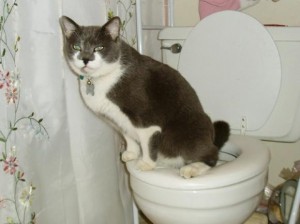Dangers of Flushing Cat Poop Down Your Toilet - Avoid Possible Issues
Dangers of Flushing Cat Poop Down Your Toilet - Avoid Possible Issues
Blog Article
The writer is making a few great annotation about Don’t flush cat feces down the toilet in general in this great article down the page.

Intro
As feline owners, it's essential to be mindful of how we dispose of our feline close friends' waste. While it may appear practical to purge cat poop down the commode, this method can have destructive effects for both the setting and human wellness.
Ecological Impact
Flushing cat poop presents harmful pathogens and parasites right into the water supply, presenting a substantial risk to aquatic environments. These impurities can negatively affect aquatic life and concession water quality.
Health and wellness Risks
Along with environmental worries, flushing cat waste can additionally position health and wellness threats to human beings. Cat feces may contain Toxoplasma gondii, a parasite that can trigger toxoplasmosis-- a potentially serious illness, specifically for pregnant women and individuals with damaged body immune systems.
Alternatives to Flushing
Fortunately, there are more secure and more responsible ways to take care of feline poop. Think about the complying with alternatives:
1. Scoop and Dispose in Trash
One of the most common approach of throwing away pet cat poop is to scoop it into an eco-friendly bag and throw it in the trash. Make certain to use a committed litter scoop and take care of the waste promptly.
2. Use Biodegradable Litter
Go with biodegradable feline trash made from products such as corn or wheat. These litters are eco-friendly and can be securely thrown away in the garbage.
3. Hide in the Yard
If you have a backyard, consider hiding pet cat waste in a marked location far from veggie gardens and water sources. Be sure to dig deep enough to prevent contamination of groundwater.
4. Mount a Pet Waste Disposal System
Invest in a pet garbage disposal system particularly designed for feline waste. These systems make use of enzymes to break down the waste, minimizing smell and environmental effect.
Verdict
Responsible family pet possession extends beyond providing food and shelter-- it additionally involves correct waste monitoring. By avoiding purging cat poop down the commode and selecting alternate disposal techniques, we can decrease our ecological impact and safeguard human health and wellness.
Why Can’t I Flush Cat Poop?
It Spreads a Parasite
Cats are frequently infected with a parasite called toxoplasma gondii. The parasite causes an infection called toxoplasmosis. It is usually harmless to cats. The parasite only uses cat poop as a host for its eggs. Otherwise, the cat’s immune system usually keeps the infection at low enough levels to maintain its own health. But it does not stop the develop of eggs. These eggs are tiny and surprisingly tough. They may survive for a year before they begin to grow. But that’s the problem.
Our wastewater system is not designed to deal with toxoplasmosis eggs. Instead, most eggs will flush from your toilet into sewers and wastewater management plants. After the sewage is treated for many other harmful things in it, it is typically released into local rivers, lakes, or oceans. Here, the toxoplasmosis eggs can find new hosts, including starfish, crabs, otters, and many other wildlife. For many, this is a significant risk to their health. Toxoplasmosis can also end up infecting water sources that are important for agriculture, which means our deer, pigs, and sheep can get infected too.
Is There Risk to Humans?
There can be a risk to human life from flushing cat poop down the toilet. If you do so, the parasites from your cat’s poop can end up in shellfish, game animals, or livestock. If this meat is then served raw or undercooked, the people who eat it can get sick.
In fact, according to the CDC, 40 million people in the United States are infected with toxoplasma gondii. They get it from exposure to infected seafood, or from some kind of cat poop contamination, like drinking from a stream that is contaminated or touching anything that has come into contact with cat poop. That includes just cleaning a cat litter box.
Most people who get infected with these parasites will not develop any symptoms. However, for pregnant women or for those with compromised immune systems, the parasite can cause severe health problems.
How to Handle Cat Poop
The best way to handle cat poop is actually to clean the box more often. The eggs that the parasite sheds will not become active until one to five days after the cat poops. That means that if you clean daily, you’re much less likely to come into direct contact with infectious eggs.
That said, always dispose of cat poop in the garbage and not down the toilet. Wash your hands before and after you clean the litter box, and bring the bag of poop right outside to your garbage bins.
https://trenchlesssolutionsusa.com/why-cant-i-flush-cat-poop/

I was brought to that article about Don’t flush cat feces down the toilet from an acquaintance on another web property. Enjoyed our posting? Please share it. Let somebody else locate it. Many thanks for your time. Please visit our blog back soon.
Call Today Report this page